The term SPWM stands for “Sinusoidal pulse width modulation” is a technique of pulse width modulation used in inverters. An inverter generates an output of AC voltage from an input of DC with the help of switching circuits to reproduce a sine wave by generating one or more square pulses of voltage per half cycle. If the size of the pulses is adjusted, the output is said to be pulse width modulated. With this modulation, some pulses are produced per half cycle. The pulses close to the ends of the half cycle are constantly narrower than the pulses close to the center of the half cycle such that the pulse widths are comparative to the equivalent amplitude of a sine wave at that part of the cycle. To change the efficient output voltage, the widths of all pulses are amplified or reduced while keeping the sinusoidal proportionality. With PWM (pulse width modulation), only the on-time of the pulses are changed during the amplitudes.
Sine Pulse Width Modulation
The hardware and software requirements of the sine pulse width modulation (SPWM) includes 8051 series Microcontroller, MOSFET, Gate Driver, Crystal Oscillator, Toggle Switches, Resistors, Capacitors, Required Diodes, Transformer, Regulator, Opto-isolators, Keil compiler, and Languages: Embedded C or Assembly.
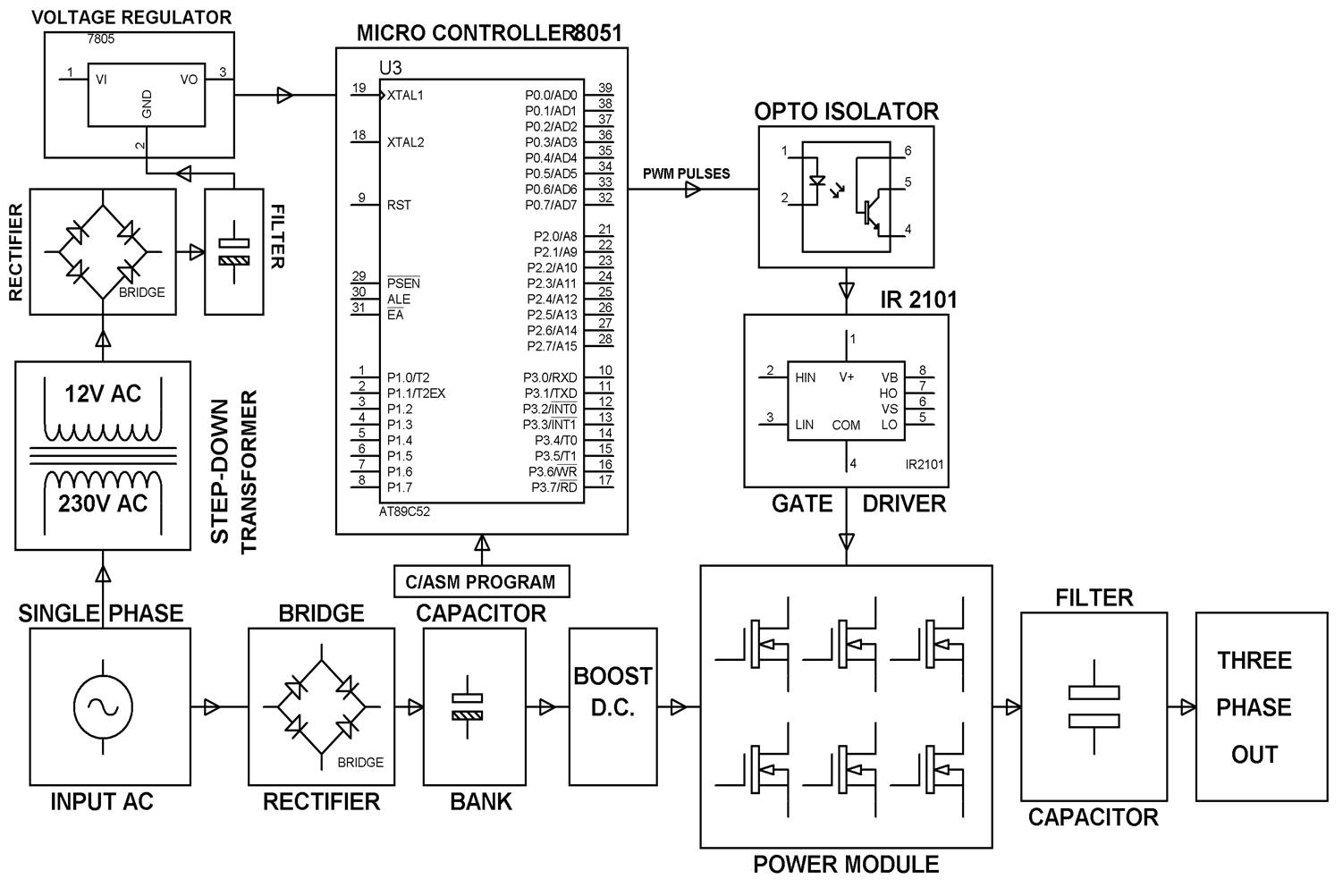
Sine Pulse Width Modulation (SPWM) Block Diagram
Power Supply
- The 230V AC supply is first stepped down to 12V AC using a step-down transformer.
- This is then converted to DC using a bridge rectifier.
- The AC ripples are filtered out by using a capacitor and given to the input pin of voltage regulator 7805.
- At output pin of this regulator, we get a constant 5V DC which is used for MC and other ICs in this project.
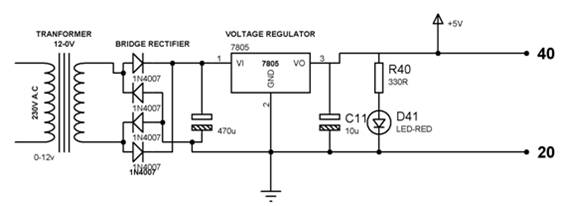
Power Supply
Microcontroller
It is a smaller computer; it has on-chip RAM, ROM, I/O ports. The features of MC include the following.
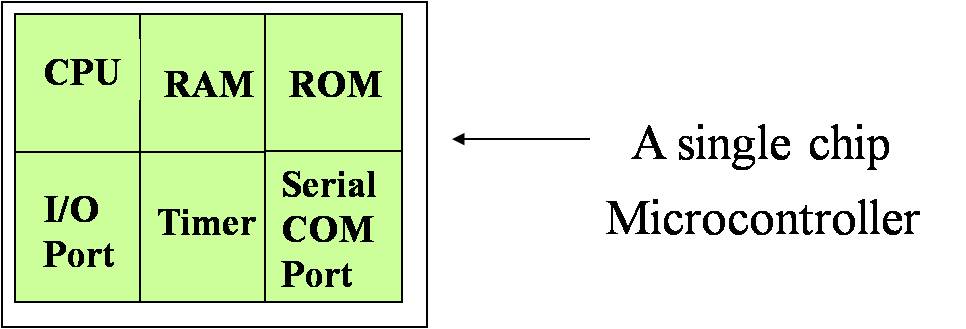
Microcontroller
-
- 8K Bytes of In-System Programmable (ISP) Flash Memory
- 4.0V to 5.5V Operating Range
- Fully Static Operation: 0 Hz to 33 MHz
- 256 x 8-bit Internal RAM
- 32 Programmable I/O Lines
- Three 16-bit Timer/Counters
- Eight Interrupt Sources
- Full Duplex UART Serial Channel
Opto-isolator
- Optocoupler is a 6 pin IC. It is a combination of 1 LED and a transistor.
- Pin 6 of the transistor is not generally used and when light falls on the Base-Emitter junction then it switches and pin5 goes to zero.
- If the input of the diode is zero and another end of the diode is GND then the output is one.
- When a logic zero is given as input then the light doesn’t fall on transistor so it doesn’t conduct which gives logic zero as output.
- When logic 1 is given as input then light falls on transistor so that it conducts, that makes transistor switched ON and it forms short-circuit this makes the output is logic zero as a collector of the transistor is connected to ground.
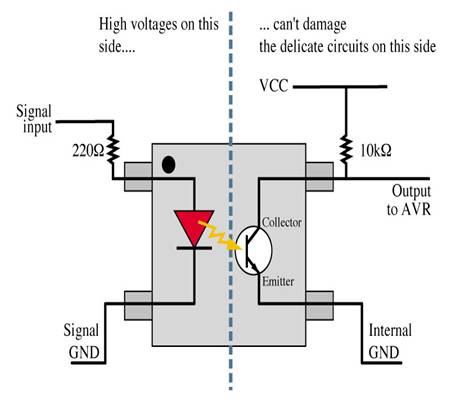
Opto-isolator
MOSFET
The MOSFET (Metal Oxide Semiconductor Field Effect Transistor) is a Voltage controlled device. This means that a voltage at the gate controls the current flows from the drain to the source. There are three terminals: Gate – connected to the input device. Drain – connected to the positive, since electrons drain away to the positive. Source – the source of the electrons.
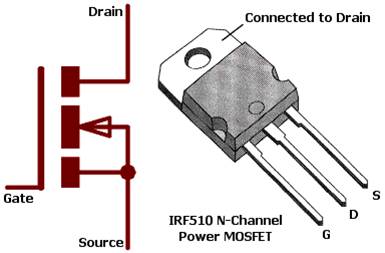
MOSFET
Uses of MOSFETS
High power devices like motors and light bulbs give a large current output for a very tiny current input. So a MOSFET can act as the interface between an integrated circuit that can give only a tiny current and the motor that takes a big current. In complimentary pairs, they are used in hi-fi power amplifiers. They produce less distortion as they are more linear than bipolar transistors, Integrated circuits, as they can be made very compact.
IR2101
The IR2101(S)/IR2102(S) are high voltage, high-speed power MOSFET, and IGBT drivers with independent high and low side referenced output channels. Proprietary HVIC and latch immune CMOS technologies enable ruggedized monolithic construction. The logic input is compatible with standard CMOS or LSTTL output, down to 3.3V logic. The output drivers feature a high pulse current buffer stage designed for minimum driver cross-conduction. The floating channel can be used to drive an N-channel power MOSFET or IGBT in the high side configuration which operates up to 600 volts.
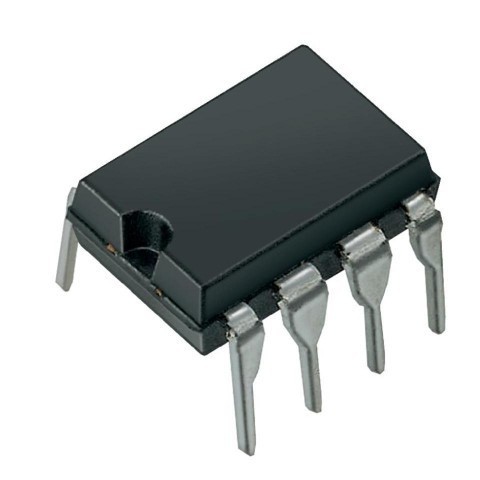
IR2101
Features of IR2101
- Floating channel designed for bootstrap operation Fully operational to +600V Tolerant to negative transient voltage dV/dt immune.
- Gate drive supply range from 10 to 20V
- Under voltage lockout
- 3.3V, 5V, and 15V logic input compatible
- Matched propagation delay for both channels
- Outputs in phase with inputs (IR2101) or out of phase with inputs (IR2102)
Working of Sine Pulse Width Modulation
Sinusoidal PWM has been an extremely famous method utilized as a part of AC engine control. This is a technique that utilizes a triangular carrier wave modulated by a sine wave and the purposes of convergence decide the exchanging purposes of the power gadgets in the inverter. Despite the fact that this technique can’t make full utilization of the inverter’s supply voltage and the asymmetrical nature of the PWM switching characteristics delivers generally high harmonic distortion in the supply it is as yet prevalent for its effortlessness.
This article describes the theory of SPWM and the task should be made utilizing a modified microcontroller of 8051 families appropriately interfaced to 3 phase inverter with 6 numbers MOSFET or IGBTs from DC got from a solitary stage or 3 stage, 50 Hz supply. The load shall be a star associated three stage 50 Hz, 440volt, and 0.5 to 1 HP engine. Then again a starlight load can be utilized to see the waveform as it were.
Please refer to this link to know more about Pulse Width Modulation MCQs, Sampling Theory and Pulse Modulation MCQs.
Further this project can be enhanced by following space vector PWM Technique for higher efficiency and low harmonic distortion for motors.